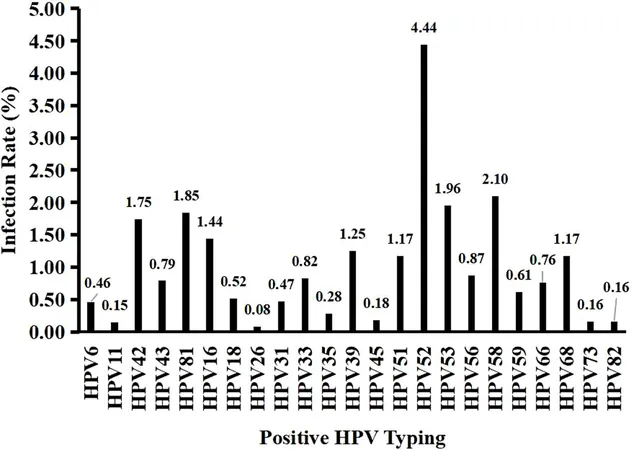
High-Risk HPV Typing: A Crucial Indicator for Cervical Lesion Risks in Changsha, China
2025-01-20
Author: Nur
Background
Cervical cancer remains a leading health challenge globally, significantly influenced by persistent infection with high-risk human papillomavirus (HPV). Regular screening using HPV typing and cytology helps women gauge their risk for cervical lesions, enabling timely interventions like colposcopy or cervical biopsies. This article presents essential findings on predicting high-grade precancerous cervical lesions specifically based on high-risk HPV typing in Changsha, China.
Methods
We analyzed retrospective HPV typing data collected from 158,565 women, which included various diagnostic procedures: 19,707 underwent ThinPrep cytologic testing (TCT), 7,539 had colposcopy, and 4,762 underwent biopsies. Our focus was on the sensitivity, specificity, and risk parameters associated with different high-risk HPV types and their correlation to high-grade lesions.
Results
The investigation revealed a 17.89% overall prevalence of HPV infections, with the most frequent types being HPV52 (4.44%), HPV58 (2.10%), HPV53 (1.96%), HPV81 (1.85%), HPV42 (1.75%), and HPV16 (1.44%). We found a strong linear correlation between the sensitivity and specificity of high-grade lesion detection and the infection rates of each HPV type. Furthermore, HPV16 was determined to present a heightened risk for developing CIN2+ lesions, emphasizing the seriousness of this infection. The most dangerous HPV types identified in biopsies were HPV45, HPV16, HPV58, HPV33, and HPV18, which underscored the need for vigilant monitoring of high-risk HPV types prevalent in the Changsha region.
Conclusion
In summary, our findings highlight that higher rates of HPV52, HPV58, and HPV53 play a crucial role in inciting high-grade cervical lesions in Changsha, China. A self-defined risk parameter was suggested to better understand the intrinsic risks linked to high-risk HPV infections. Continued surveillance, especially among the high-risk types noted, is essential in preventing cervical cancer progression.
Ethics and Sample Collection
This study received ethical approval from the Medical Ethics Review Committee of Changsha Maternal and Child Health Hospital. All women aged 35-64 years participating in the Changsha Health and Livelihood Program signed informed consent, excluding those with acute infections, menstruation, or a known history of cervical cancer.
Diagnosis and Testing Methods
Samples for HPV testing were collected and analyzed for 23 HPV types. On the basis of Chinese cervical cancer screening guidelines, direct referrals for colposcopy were made for positive HPV16 and HPV18 results.
Data Analysis
Analyses included Infection Rate, Sensitivity, Specificity, Positive Predictive Value (PPV), and Odds Ratios (OR) for various HPV types, establishing associations with the risk of high-grade lesions.
Findings Summary
1. **Prevalence:** 17.89% HPV positive rate with a notable comparison to similar studies in Shanghai. 2. **Detection Effectiveness:** Strong correlations observed between HPV infection rates and sensitivity in detecting high-grade lesions. 3. **Pathogenicity Risk:** Acknowledged varying risk factors linked to co-infections in HPV types, further emphasizing the complex nature of cervical lesion diagnostics.
Call to Action
With the progressive HPV vaccination efforts, there’s an urgent need to monitor vaccination impacts on infection trends and mitigate cervical cancer risks. Early detection through regular screenings and HPV vaccinations can significantly curtail the incidence of cervical malignancies, ensuring women's health is prioritized.
Summary
In summary, this study substantiates the prominence of regular HPV typing in predicting cervical cancer risks, advocating for enhanced screening protocols to address this pressing health concern in Changsha, China.


 Brasil (PT)
Brasil (PT)
 Canada (EN)
Canada (EN)
 Chile (ES)
Chile (ES)
 Česko (CS)
Česko (CS)
 대한민국 (KO)
대한민국 (KO)
 España (ES)
España (ES)
 France (FR)
France (FR)
 Hong Kong (EN)
Hong Kong (EN)
 Italia (IT)
Italia (IT)
 日本 (JA)
日本 (JA)
 Magyarország (HU)
Magyarország (HU)
 Norge (NO)
Norge (NO)
 Polska (PL)
Polska (PL)
 Schweiz (DE)
Schweiz (DE)
 Singapore (EN)
Singapore (EN)
 Sverige (SV)
Sverige (SV)
 Suomi (FI)
Suomi (FI)
 Türkiye (TR)
Türkiye (TR)
 الإمارات العربية المتحدة (AR)
الإمارات العربية المتحدة (AR)